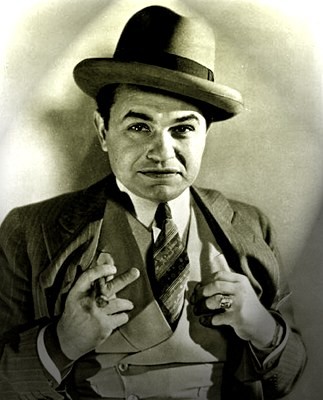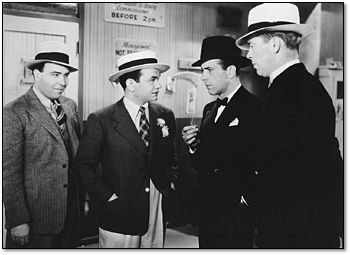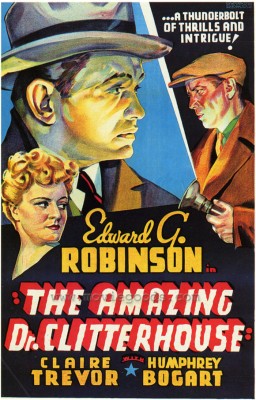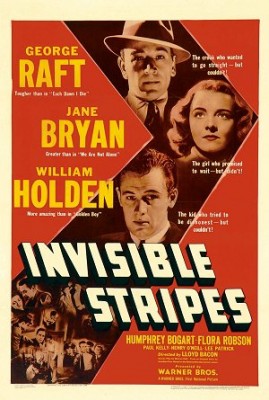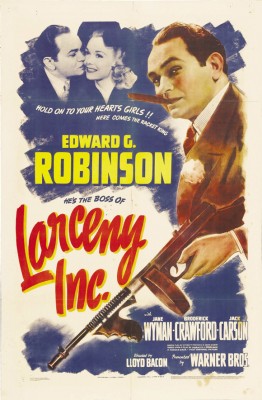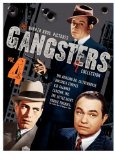| Reviews & Columns |
|
Reviews DVD TV on DVD Blu-ray 4K UHD International DVDs In Theaters Reviews by Studio Video Games Features Collector Series DVDs Easter Egg Database Interviews DVD Talk Radio Feature Articles Columns Anime Talk DVD Savant Horror DVDs The M.O.D. Squad Art House HD Talk Silent DVD
|
DVD Talk Forum |
|
|
| Resources |
|
DVD Price Search Customer Service #'s RCE Info Links |
|
Columns
|
|
|
Warner Bros. Gangsters Collection Vol. 4 (Little Giant/Kid Galahad/The Amazing Dr. Clitterhouse/Invisible Stripes/Larceny, Inc.)
Though quite charming, The Little Giant isn't so much a gangster thriller as it is a class-conscious comedy in the Frank Capra mode. Indeed, it has so many elements in common with Capra's films from the early to mid-1930s that it's almost surprising that he had nothing to do with it. The picture cleverly makes Edward G. Robinson's Little Caesarian character utterly sympathetic by dropping him into a world of high society far more cut-throat and scurrilous than the Chicago mob.
When Prohibition is repealed, notorious Chicago bootlegger Jim "Bugs" Ahearn (Robinson) decides to put the crime world behind him and retire to Santa Barbara with his millions. Taking gangster pal Al Daniels (Russell Hopton) along for the ride, Bugs hopes to be accepted into the world of High Society, and makes a sincere effort to learn the ways of the privileged class.
He soon falls in with the conniving Cass family who, despite their arrogance, in fact are trying to scheme their way back to solvency. Mr. Cass is a crooked banker looking to dump his troubled company off on Bugs, while his daughter, Polly (Helen Vinson), is a gold-digger playing Bugs for a sap. One minute she's practically thrusting her breasts into his face (this being Pre-Code Hollywood), while moments later she's French-kissing her boyfriend. Meanwhile Ruth Wayburn (Mary Astor), working as a realtor but in fact the disgraced owner of the house Bugs is renting, watches helplessly as the loveable lug makes a fool of himself trying to impress his neighbors - while they laugh at him behind his back.
Though singularly manipulative in the Capra manner, The Little Giant is also enormously effective; I'll bet 1933 audiences, still in the grips of the Great Depression, cheered when the Cass family and their associates finally get their well-earned comeuppance. Simultaneously snooty and unscrupulous, the Cass Family must rank among the nastiest and most disagreeable families in all of moviedom.
But what really makes The Little Giant click are Robinson and Astor. Where the rest of the cast give performances in line with other early-'30s films, both Robinson and Astor are much less theatrical, more naturalistic. The same film with, say, Jimmy Cagney and Glenda Farrell would have been quite different. Here, in their scenes together, Robinson and Astor have low-key conversations that have an intimacy and authenticity rare in early-'30s Hollywood; both are excellent. He's downright cute in his earnest efforts to improve his social standing, while she's sympathetic and sexy.
The film would fit right in with Warner Home Video's Pre-Code Hollywood DVD releases. When Bugs shows off a newly-purchased futurist painting, asking "Have you ever seen anything like that before?" Al responds, "Not since I've been off cocaine." Astor's character calls Vinson's gold-digger a "sister-in-law to the world."
And, historians, take note: In one scene Bugs is seen reading Vanity Fair. On the cover is a giant swastika, making this one of the first features to reference Nazi Germany. Rating: (****)
Kid Galahad, on television for many years as Battling Bellhop to avoid confusion with its 1962 remake (starring Elvis) is a terrific film. A boxing melodrama featuring Edward G. Robinson and Bette Davis it's hokey and predictable but beautifully acted across the board, while the Seton I. Miller-Francis Wallace screenplay provided them goes a long way to flesh their characters out. In other words, it works - so well in fact that it exemplifies the Warner Bros. studio system of the 1930s at the top of its game.
This time Robinson plays Nicky Donati, a hot-headed fight manager. A control freak, he's so obsessed that his sister, Marie (Jane Bryan), will run off with one of his fighters that he ships her off to a convent. Meanwhile, he demands so much loyalty from his fighters that he drops 'em like a hot potato the minute they show a modicum of independence.
Nicky and his kind-of girlfriend, Louise "Fluff" Phillips (Davis) find a new fighter in Ward Guisenberry (Wayne Morris), a one-time farm boy-turned-bellhop, who surprises everyone attending Nicky's party when Ward, protecting Louise, slugs heavyweight champion Chuck McGraw (William Haade), knocking him to the floor. This doesn't sit well with racketeer / fight promoter "Turkey" Morgan (Humphrey Bogart, the only real gangster in sight in this picture), who owns McGraw's contract.
When Morgan catches up with Ward in New York and tries to bully the young fighter into signing with him, Ward slugs Morgan, too. Worried that Ward's life may be in danger, Louise sends the young man to the upstate farm of Nicky's mother (Soledad Jiménez) and sister. This doesn't sit well at all with Nicky, while both Marie and Louise each fall in love with Ward, newly rechristened "Kid Galahad."
The three-dimensionality of the characters make Kid Galahad so memorable. Nicky's need to control everyone around him, even when his actions are totally self-destructive, is the heart of the picture, and there's a big pay-off to this character development during the climax, when the entire outcome hinges on his behavior and self-realization. Ward is another surprisingly effective character, naïve but definitely not stupid, he knows he's in it just for the money, but is also indefatigably loyal to Nick. It's a difficult tightrope to walk; I can't think of anyone who's pulled off such a similar balance of charming innocence and worldliness since Christopher Reeve in the first Superman movie. Good as Robinson, Davis, and Bogart all are, it's Wayne Morris and Jane Bryan who make the biggest impression.
She has several fine scenes, little moments that mean a lot. The audience learns she loves him in a close shot of her hands while she listens to one of his fights on the radio - worried for him, she nervously, unconsciously tears a newspaper into tiny little pieces. Later in the film, the two young lovers are sitting with Davis' Louise at a nightclub and, referring to their mutual love for Ward, Louise turns to Marie saying, "You know, don't you?" To which Marie, understanding, simply says, "Uh-huh," while innocent Ward has no idea what the two women are talking about. It's a great little scene.
Both Robinson and Davis are excellent with their characters' relationship, built on winning and throwing away several fortunes, played with great subtlety. Bogart's Turkey, alas, is just another post-Petrified Forest, pre-High Sierra thug, though Bogie still manages to infuse it with the usual panache. (****)
No this isn't the movie about syphilis; that was Dr. Ehrlich's Magic Bullet (1940). But The Amazing Dr. Clitterhouse is pretty amazing all the same; despite its roots in a popular and respected British play (by Barré Lyndon) and the presence of stars Edward G. Robinson, Claire Trevor, Donald Crisp, and Humphrey Bogart, the film's premise is too outrageous to be believed. And Robinson, though earnest, is woefully miscast. The ridiculousness of the story and the actors keep it fun, however.
Dr. Clitterhouse (Robinson) is a high society Park Avenue physician; an intellectual's intellectual, erudite and sophisticated. It turns out that he's also living a double life, committing a series of jewel robberies - all in the interest of science, mind you. Later, he joins a gang allied with a glamorous fence, Jo Keller (Stagecoach's Claire Trevor; she, Robinson, Bogart, and co-screenwriter John Huston would all re-team for the far superior Key Largo). So savvy is Dr. Clitterhouse that overnight he becomes the gang's leader, toppling a resentful "Rocks" Valentine (Bogart).
The arrangement is bizarre, to say the least. Even while in the midst of committing crimes Clitterhouse monitors the heart rate, blood pressure, pupils and whatnot of the various criminals (including "Slapsie" Maxie Rosenbloom, Curt Bois, Ward Bond, and Vladimir Sokoloff), even drawing their blood after each getaway. No one seems to regard this as particularly strange. Eventually crime becomes a kind of narcotic for Clitterhouse, and his behavior gets out of hand.
The play was set in London and on the stage Clitterhouse was played by Cedric Hardwicke. For the movie, Robinson adopts a vaguely New England accent, though unfortunately he comes off like Edward G. Robinson doing an imitation of Arthur Treacher. Director Anatole Litvak reportedly wanted Ronald Colman for the part; that would have been an infinitely better choice, though Robinson is too good an actor to give a bad performance in spite of his inappropriateness.
His monomaniacal character seems to have been an attempt to analyze the blithely amoral personality, the kind of person documented so well by Errol Morris in his film Mr. Death (1999), but here Robinson merely seems slightly ridiculous. What is he researching exactly anyway, what aspect of the criminal mind and/or physiology would benefit from such in-the-trenches research? We never find out.
The film is unintentionally funny in other ways (at times the film clearly is trying to be funny, though other times it's not but it is): Humphrey Bogart, playing the kind of stock gangster part that plagued him during this period keeps calling Robinson's character in the classic sardonic Bogie manner: "Doctor Clitterhouse." It's funny instead of threatening.
(Spoilers) Perhaps what's most interesting about The Amazing Dr. Clitterhouse is how it sort of circumvents the Hollywood Production Code, in full swing by 1938. Without giving too much away, one major character who commits multiple robberies and an especially cold-blooded murder gets away pretty much scot-free. (** 1/2)
Invisible Stripes is terrific jumble of gangster and prison picture iconography, social commentary and hokey melodrama. George Raft, the stiff but iconic movie gangster, is top-billed and definitely the picture's central focus, but nearly equal weight is given to a very young William Holden as Raft's kid brother and Humphrey Bogart as Raft's unrepentant prison-mate.
Contrite Cliff Taylor (Raft) is paroled after a long stretch - five years - in Sing Sing. He's determined to go straight and get his life back on track while career criminal Charlie Martin (Bogart) thinks his friend is a chump for naively believing he'll ever be accepted back into society.
Though warmly welcomed back home by his mother (Flora Robson, a bizarre casting choice)* and kid brother, Tim (a baby-faced Holden), Cliff soon finds no one will hire him because of his record. What's more, his old girlfriend immediately dumps him and the police haul him in every time there's a crime in the neighborhood. Tim, meanwhile, has what Rod Serling used to call "a chip on his shoulder the size of the national debt." A struggling auto mechanic unhappily engaged to Peggy (Jane Bryan again, who's still with us and just turned 90!), he wants to provide her with a better life but he's just scraping by. Only Martin, reunited with his old gang (including Marc Lawrence as his chief rival) is swimming in cash.
Despite restrictions from the Production Code, Invisible Stripes is highly critical of prejudicial police officers, of everyday businessmen overly suspicious to ex-cons who have paid their debt to society. The film is really in Cliff's corner, but it also makes clear that the deck is simply stacked against him.
Raft is an undeniable presence but extremely limited as an actor. He was probably just fine on radio, but in the movies his movements are stiff (he walks like he's wearing an invisible neck brace) and the face is practically immobile. Still, he manages to create a compelling, sympathetic character even as Holden and especially Bogart act rings around him anytime they're in the same scene.
Fans of character players will delight in all the familiar faces turning up here, often in uncredited bit parts, including John Hamilton, Frankie Thomas, Bruce Bennett, Frank Faylen, Leo Gorcey, William Hopper, and Victor Kilian. Bogie and Lee Patrick, later Sam Spade's devoted secretary in The Maltese Falcon share a fun scene together. (*** 1/2)
Based on the unsuccessful (22 performances) Broadway play The Night Before Christmas by Laura and S.J. Perelman, Larceny, Inc. is a pretty good comedy about three ex-cons (Edward G. Robinson, Broderick Crawford, and Edward Brophy) who plan to rob a Manhattan bank by taking ownership of a luggage shop next door and tunneling their way to the bank's riches.
Problem is no matter what they do to discourage business, including being extraordinarily rude to their customers, the hapless watch helplessly as the down-on-its-luck business becomes a thriving concern, and Robinson's character inadvertently the toast of the neighborhood. If all this sounds familiar, that's because the first-half of Woody Allen's Small Time Crooks is virtually an uncredited remake.
This minor but amusing comedy has winning characters; it's especially nice to see Brophy in such a prominent part, sharing almost every scene with Robinson. Brophy is remembered today as the voice of Timothy Mouse in Dumbo, but the short, bald and stocky actor appeared in about 150 movies, usually smallish supporting parts in A-films and larger supporting parts in Bs. He seems to have never turned down a part, because he freely alternated between the exclusive glamour of MGM and the desperate economy of Poverty Row.
Though Crawford plays the kind of imbecilic dolt that marked his early career (following his stage success as Lennie in Of Mice and Men), Brophy and Robinson play funny characters, career criminals gradually drawn into the world of legitimate salesmanship. The terrific supporting cast includes Jane Wyman and Jack Carson, and in an uncredited role as a soda jerk, Jackie Gleason. (*** 1/2)
Video & Audio
The five full-frame titles are all Warner Bros. releases and, unlike the problem-plagued RKO library, are in very good condition overall. Except for a few seconds here and there of nitrate negative damage and a missing frame or two, they all look pretty darn good, rich in detail with strong blacks and excellent contrast. The features but not the supplements include optional English and French subtitles (why not Spanish?). The mono audio on all the films is strong considering their age. The video/audio quality of the supplements is another matter; they run the gamut from superb to poor (see below).
Extra Features
The big enchilada here is an excellent 105-minute documentary, Public Enemies - The Golden Age of the Gangster Film. In 16:9 widescreen and directed by Constantine Nasr, it traces the genre from the early silent era to the present, naturally focusing on the 1930s and '40s at Warner Bros., though the studio did spring for clips from other genre highlights such as the original, Universal-owned Scarface. It's mostly a clip show interspersed with interviews with film historians, but they include heavyweights like Sir Christopher Frayling, Peter Travers, Molly Haskell, Anthony Slide, Rick Jewell, Kim Newman, and many others.
Some of these same historians turn up in the audio commentaries that accompany each film. They vary widely in terms of interests, scope, density of material, and overall value, though the best ones are quite interesting. Some are packed with good information and observations culled from much research and thoughtful consideration, while a few do little more than describe what's obviously unfolding onscreen. Trailers are also included with each film. The one for Kid Galahad features Edward G. Robinson and Bette Davis in footage shot especially for the trailer.
Each disc is accompanied by a collection of contemporary short subjects, viewable as one big program with the feature film or separately as "extras." Most include a trailer for a movie released that same year, a "newsreel" (see below), a cartoon, a one-reel musical short, and a two-reel dramatic or musical comedy short. The Little Giant's "Warner Night at the Movies" includes newsreel footage about the repeal of prohibition (thus linking it to the feature); a really fun musical short called Use Your Imagination, about an unemployable daydreamer (Hal Le Roy) whose runaway imagination keeps getting him fired. The short features some great dancing by lanky Tommy Tune-esque Le Roy. Also included is a surreal Rudolf Ising cartoon, The Dish Ran Away with the Spoon, co-drawn by Bob McKimson.
Both Kid Galahad and The Amazing Dr. Clitterhouse's supplements include Paul Harvey-esque "Your True Adventure" shorts hosted by one-eyed "headline hunter" Floyd Gibbons. They're pretty amusing. Toyland Casino, in abysmal condition, is a kiddie musical revue clearly feeding off the popularity of the Our Gang comedies, but without that series' charm. Familiar TV character actor Bob Hastings is one of the kids. Two radio adaptations, both starring Edward G. Robinson, are included.
Invisible Stripes' "Night at the Movies" runs more than an hour. By far the most interesting of the shorts is the fascinating The Monroe Doctrine (released October 14, 1939, take note), a lavish two-reel Technicolor dramatization of the landmark 1823 tenet of American foreign policy, to treat an invasion by any European nation against any North or South American nation as an act of war against the United States itself. Why would Warner Bros. put so much money into such a film, you ask? Clearly the studio was trying to draw parallels with current events in Europe, to make the case for war with Germany to a largely isolationist American audience. It's a fascinating film.
Less so is Mr. and Mrs. Jesse Crawford at Home, featuring the famous organists performing with other acts for the benefit of Percy Helton, mistaken for a gas company executive. Another Technicolor short, Quiet, Please, is an overproduced musical-comedy set on a Hollywood soundstage, and features Fritz Feld as the stereotypically Teutonic director, complete with monocle. One of the two cartoons featured, Hare-um, Scare-um features a proto-Bugs Bunny and Elmer Fudd.
Larceny, Inc. includes what would be little more than an extended commercial, a recruitment film for the Army Air Force, were it not hosted by Jimmy Stewart, by 1942 already a seasoned flyer though still a year away from active combat duty. The two-reeler paints such a glamorous portrait of the service - there's no mention of the possibility of getting fried like a tater-tot in one of those B-17s - you'd just about have to be a fool not to sign up then and there - and I suspect the extended black at the end while the music continues on was to do just that, in movie theaters across America. Two cartoons, one featuring a bee that talks like Jimmy Cagney, round out the program.
Two complaints about these supplements: for some reason, most of these shorts use inferior masters rife with video noise, flaccid color and other problems. (This is most obvious with the cartoons.) It would be nice if this material were remastered along with the feature films. The other issue, more problematic, is that what're being passed off as newsreels are really newsreel excerpts, often lacking audio. In some cases they're not even that; Kid Galahad features what look like raw dailies of an FBI story featuring J. Edgar Hoover. The footage looks great, hot off the camera negative, but also features endless takes, close-ups, and alternate angles of a printing press (!). While generally chosen to tie-in to the feature film (newsreel footage of the repeal of Prohibition with The Little Giant, for instance), to call such things "newsreels" is really misleading. (Someone ought to compile complete newsreels all by themselves for DVD release.)
Parting Thoughts
I passed on the first volume of the Warner Bros. Pictures Gangsters Collection because I had seen all those movies multiple times. These five were much less familiar, and though most are several notches below Public Enemy or Key Largo each has something to offer - it's hard to complain about four Edward G. Robinsons, three Bogies, and a Raft - and the supplements make this an extraordinarily fun package. Highly Recommended.
Film historian Stuart Galbraith IV's latest book, The Toho Studios Story, is on sale now.
* Raft was actually seven years older than the actress playing his mother, British-Scottish Robson. They don't look anything alike, her makeup isn't convincing, and for that matter, neither much looks like Holden, either.
|
| Popular Reviews |
| Sponsored Links |
|
|
| Sponsored Links |
|
|
| Release List | Reviews | Shop | Newsletter | Forum | DVD Giveaways | Blu-Ray | Advertise |
|
Copyright 2024 DVDTalk.com All Rights Reserved. Legal Info, Privacy Policy, Terms of Use,
Manage Preferences,
Your Privacy Choices | |||||||









